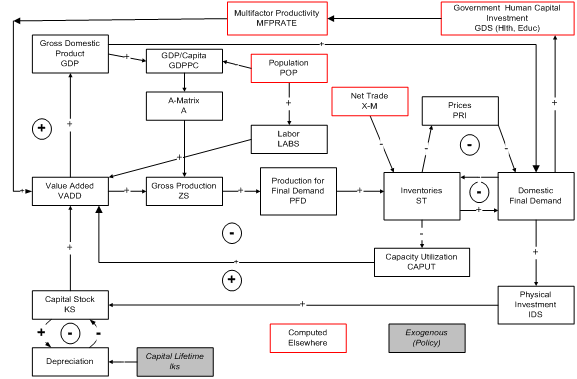International Futures Help System
Economic Flow Charts
Overview
This section presents several block diagrams that are central to the two major components of the economics model, the goods and services market—with special emphasis on the production function— and the broader SAM.
The economic model represents supply, demand, and trade in each of six economic sectors: agriculture, primary energy, raw materials, manufactures, services, and information/communications technology. The model draws upon data from the Global Trade and Analysis Project (GTAP) with 57 sectors as of GTAP 8; the pre-processor collapses those into the six IFs sectors and theoretically could collapse them into a different aggregated subset.
Inventories (or stocks) are the key equilibrating variable in three negative feedback loops. As they rise, prices fall, increasing final demand (one loop), decreasing production (a second loop), and thereby in total decreasing inventories in the pursuit over time of a target value and equilibrium. Similarly, as inventories rise, capacity utilization falls, decreasing production, and restraining inventories.
Physical investment and capital stocks are the key driving variables in an important positive feedback loop. As capital rises, it increases value added and GDP, increasing final demand and further increasing investment. Similarly, government social investment can increase productivity, production and inventories in another positive feedback loop.
The figure below also shows some production detail. A-matrices, which are specified dependent on the level of development (GDP per capita), allow the computation from value added of gross production and of the production that is available, after satisfaction of intersectoral flows, for meeting final demand. It is the balance of this production for final demand with actual final demand that determines whether inventories grow or decline.

The calculation of gross production (ZS) in value terms within the economic model is overridden by calculations of physical production converted to value in the agricultural and energy models when respective switches (AGON and ENON) are thrown as in the default of the IFs Base Case scenario.
For more, please click on the links below.
- Value Added
- Multifactor Productivity
- Economic Aggregates and Indicators
- Household Accounts
- Firm Accounts
- Government Accounts
- Savings and Investment
- Trade
- International Finance
- Income Distribution
- Poverty
 International Futures at the Pardee Center
International Futures at the Pardee Center